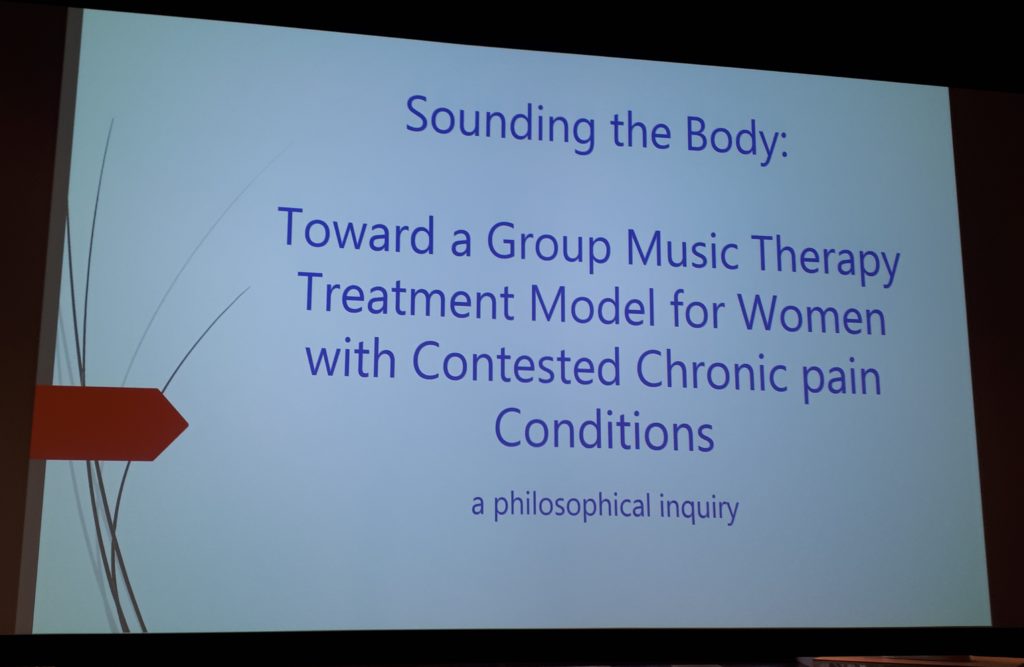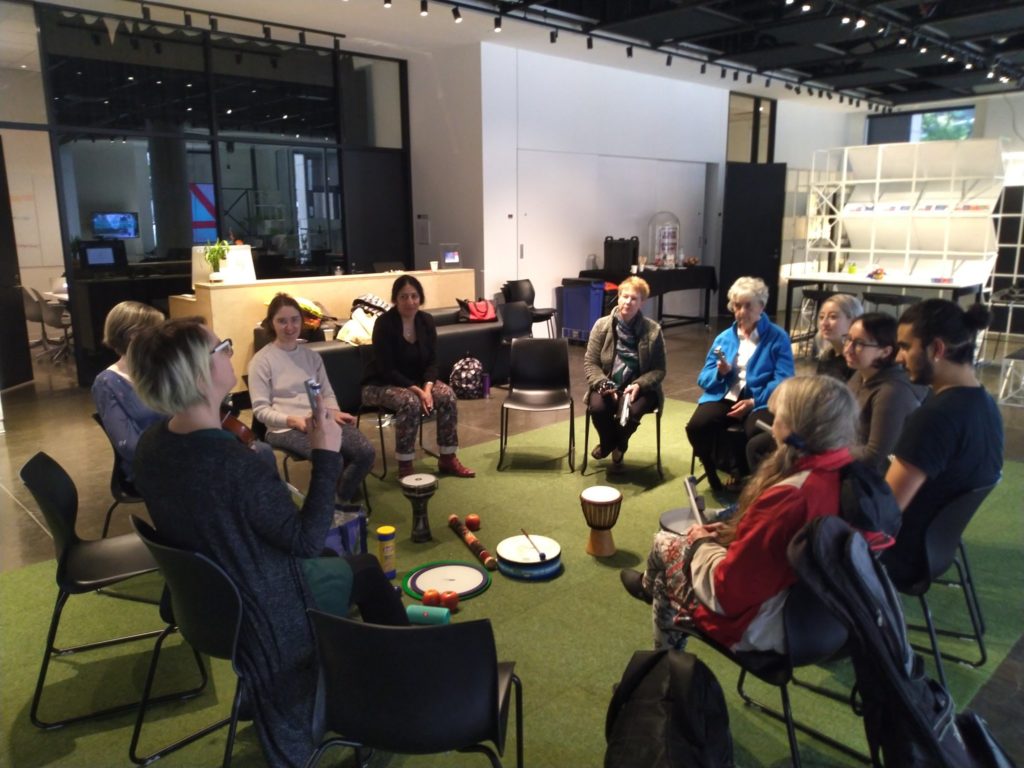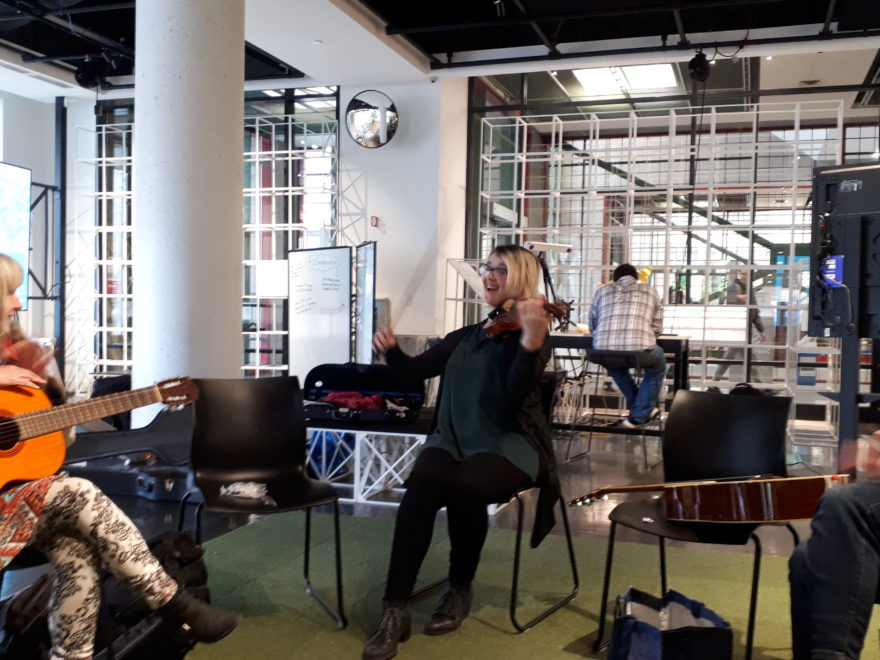I’ve already written a few posts about Play the Pain(1), a two-day event that took place in Montreal last week. Centred around the idea of using creativity and play as tools for the management of chronic pain, it included scientific presentations and several interactive workshops.
There were so many sessions, and so much information provided during the course of each, that it’s taking me a while to describe them all! Bear with me, and I’ll try to post each of them by the end of the month ‘-)
I’m also dealing with some post-event exhaustion, as the packed schedule and then longer-than-usual drives home triggered a flare of autoimmune fatigue from CRPS; Complex Regional Pain Syndrome.
The sessions ran back-to-back, from 1000 right through until 1800, with only a half-hour break for lunch. On top of that, I had a drive of over an hour each way; much longer on the first day due to a flooded-out road on my way home. There aren’t many public transit options in my area, although a new train should be coming into service within the next few years ‘-)
So far I’ve posted a description of the interactive workshop on creative writing and pain, as well as a presentation on the neuroscience of pain. Today I’d like to write about a combination of a scientific presentation and another interactive workshop, this time focusing on group music therapy.
This presentation, augmented by a one-hour session, was conducted by Ingrid Wissink. This closed out the second morning of Play the Pain. Ingrid is not only an accredited music therapist, and a musician herself, she is also a researcher in the field of chronic pain:
currently studying toward her Master’s in Music Therapy from Concordia University.
Her thesis research focusses on the impact of group music therapy from an anti-oppressive approach for women living with the physical and psychosocial consequences of contested chronic pain conditions.
She is currently working with children with autism as part of Montreal’s Music Hive collective as well as running memory care groups for seniors living with dementia.”(2)
“In collaboration with the Homebase movement, she explores drumming and improvisation experiences, as well as lyrical emotional expressions in group therapy.”(1)
Ingrid is also a dynamic and engaging presence, and was able to draw out individuals who had otherwise not actively participated in the various elements of Play the Pain. Her research presentation was an overview of her work with women living with ‘contested chronic pain conditions’. What this means, in plain English, is that these women have been disbelieved, dismissed or disregarded in terms of the pain experience.
This has been common for women with fibromyalgia, for example. It is, sadly, also common for many individuals living with invisible chronic pain conditions. To a certain extent, I experienced that myself during the three months it took for me to obtain a diagnosis of CRPS; Complex Regional Pain Syndrome.
Because chronic pain inordinately affects women, by default women have the most experience in dealing with these conditions. Unfortunately, there is a long history of women not having been taken seriously by the medical establishment. I wrote about that last year; the view of women’s ‘hysteria’ in ‘pain catastrophizing’.
Ingrid’s presentation was entitled “Sounding the Body: Toward a group music therapy treatment model for women with contested pain conditions”. She discussed the long-term psychological impact that being disbelieved or distrusted – by nurses, pharmacists, physicians, and other healthcare professionals – can have a woman’s life.

A patient who has experienced this rejection, in a healthcare setting, may then choose not to visit a healthcare professional for other health issues; pregnancy is an example, or screening for diabetes when there’s a strong family history of this disease.
There is a real danger in alienating women from healthcare, and Ingrid hopes to address this using group musical therapy as an interventional approach.
After the presentation, we took part in a group music workshop. Ingrid pointed out that, because she didn’t know each of us, this wouldn’t be considered music therapy; that requires a therapeutic relationship.
There were about ten of us participating in this workshop; the students and researchers had left, to return to their classes or jobs, and a few others had gone out to get some lunch.
She had brought a variety of musical instruments to the event, all of which could be played by folks without any training in music; small drums, maracas, rain sticks, tone chimes, and more. Ingrid had her violin, and one of the participants had brought her own guitar.
To start off the session, Ingrid had us warm up by simply choosing an instrument and then using it to make sounds – all at the same time. Yes, it sounded horrible! And rather loud, too ‘-) After our warm-up, Ingrid led us with her violin and had us use our chosen instruments to keep time with the music; to find a beat.
When she thought we were ready to try to carry a tune together, as a group, Ingrid brought out a set of very cool instruments. I think they were called tone chimes. Each one was like a hand-held stick, with a chime and sound chamber at one end. They were each marked with a specific note and octave, so that they could create a harmony when used together.

And I was absolutely horrible at this! We each had to remember the order in which we were to play our chimes, and I couldn’t remember when to play mine. I would have been much better at this before CRPS caused the minor cognitive impairment (MCI) with which I’m dealing these days!
I finally figured out that I could remember who would chime before me, so was able to participate that way ‘-)
It was easy to see how, with a true therapeutic relationship, music therapy could draw people out and encourage them to share in a group setting. We saw that happen with a group of strangers at Play the Pain, in less than an hour!
Thanks for reading! If you’re interested in the types of scientific presentations and interactive workshops that were conducted during Play the Pain, stay tuned for more. Have a happy day!
References
(1) Play the Pain. Media Health; Concordia University [Media Health Lab is a collaborative initiative supported by Concordia University PERFORM Centre and The Milieux for Arts, Culture and Technology]. 2019. Online. Accessed 06 Oct 2019:
http://media-health.ca/events/play-the-pain-4thspace/
(2) Art Hives. Music Hive with Native Montreal for Children and Youth. 15 July 2019. Online. Accessed 06 Oct 2019:
https://arthives.org/music-hive-native-montreal-children-and-youth

